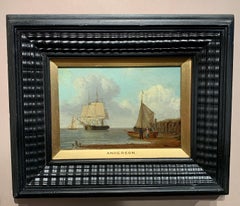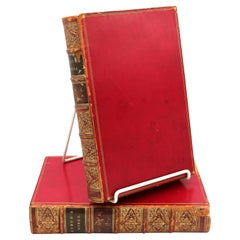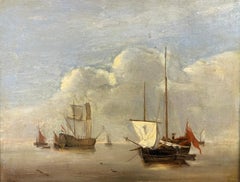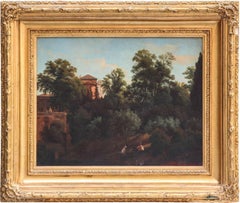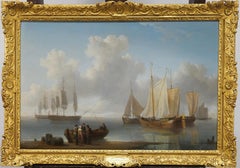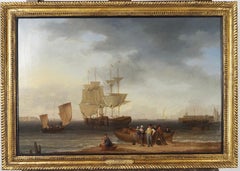William Anderson Art
British, 1757-1837
William (or Wiliam) Anderson (1757 – 27 May 1837) was a Scottish artist specializing in maritime and patriotic themes. He was well-regarded for his detailed and accurate portraits of ships under sail, exhibiting his works annually in London between 1787 and 1811 and then occasionally until 1834. Anderson influenced other artists, notably John Ward and others of the Hull school. Anderson's early life is obscure, but he is known to have trained as a shipwright before moving to London to become a maritime painter when he was about 30. His training served him well as a painter, providing "a practical nautical knowledge" of his subjects. He earned a reputation for "accuracy and refinement of detail" and was admired for his bright, clear colours. He worked in both oils and watercolours.
He based his style on that of well-known Dutch maritime painters of the 17th century. He first exhibited at the Royal Academy in 1787 and the Royal Institution in 1810, and continued to exhibit annually until 1811. He then exhibited intermittently until 1834.[6] His best work was executed in the years 1790–1810, during the French Revolutionary and Napoleonic Wars, at which time the demand for naval paintings was high. His painting was not restricted to marine subjects and included an exhibit in 1822 of a painting depicting the Battle of Waterloo. Like other artists of the time, Anderson's paintings of marine incidents were often based on sketches by participants and were bought by individuals who had risen in social standing and wealth during the wars.
Commissions that took Anderson back north introduced him to the Hull school of painters, notably influencing the young John Ward (1798–1849), who copied at least one of Anderson's paintings. He was also a friend and possibly a collaborator of the painter Julius Caesar Ibbetson (1759–1817). His work was influenced by his travels in the North, which led to depictions of Berwick-on-Tweed and Tynemouth. His last exhibit was of Lord Howe's fleet at Spithead at the Royal Academy in 1834, the last of 45 paintings that he exhibited there. He died in London on 27 May 1837.to
1
2
1
2
1
1
1
1
1
1
1
Antique English 19th century marine scene
By William Anderson
Located in Woodbury, CT
Outstanding English late 18th / early 19th century marine scene by one of Britain's best known and sought after painters.
William (or Wiliam) Anderson (1757 – 27 May 1837) was a Scottish artist specializing in maritime and patriotic themes. He was well-regarded for his detailed and accurate portraits of ships under sail, exhibiting his works annually in London between 1787 and 1811 and then occasionally until 1834. Anderson influenced other artists, notably John Ward and others of the Hull school.
Anderson's early life is obscure, but he is known to have trained as a shipwright before moving to London to become a maritime painter when he was about 30. His training served him well as a painter, providing "a practical nautical knowledge" of his subjects. He earned a reputation for "accuracy and refinement of detail" and was admired for his bright, clear colours. He worked in both oils and watercolours.
He based his style on that of well-known Dutch maritime...
Category
1810s Old Masters William Anderson Art
Materials
Oil, Wood Panel
$5,167 Sale Price
35% Off
Georgian Victorian Marine Oil Painting Shipping Scene possibly Isle of Wight
By William Anderson
Located in ludlow, GB
Georgian or early Victorian Marine Oil on Panel of busy shipping scene with figures on Harbour, possibly the Isle of Wight
A rare gem of a painting, a Georgian era oil painting sho...
Category
Late 18th Century William Anderson Art
Materials
Oil
1850 Two-Volume Set of Lord Byron's Illustrated Works
By Lord Byron, William Anderson
Located in Chapel Hill, NC
1850 two volume set of Byron's Works, printed by A. Fullerton, Edinburgh. Scarlet Morocco leather & gilt bound set filled with superb steel engravings of Italy, etc. Lord Byron's hom...
Category
1850s Scottish Victorian Antique William Anderson Art
Materials
Leather, Paper
Related Items
Shipping in Calm Waters, 18th Century Dutch Oil on Wood Panel, Man o War
Located in Cirencester, Gloucestershire
Shipping in Calm Waters
Dutch School, 18th century
oil painting on wood panel
panel: 10 x 12.75 inches
framed: 14 x 17 inches
condition: very good, minor evidenc...
Category
18th Century Old Masters William Anderson Art
Materials
Oil, Wood Panel
$2,416 Sale Price
20% Off
H 14 in W 17 in D 1 in
19th Century Roman Landscape oil on canvas with Giltwood Frame
Located in Rome, IT
Amaizing 19' century Roman landscape depicting a part of Villa Borghese with Trinità dei Monti.
With a finely carved gilt wood coeval frame.
Measurements with frame cm 65 x78 wit...
Category
19th Century Old Masters William Anderson Art
Materials
Oil
$5,386
H 25.6 in W 30.71 in D 1.97 in
17th century Flemish seascape - Stormy Sea with Merchant Vessels and dolphins
By Bonaventura Peeters the Elder
Located in Aartselaar, BE
Bonaventura Peeters the Elder (1614–1652) attr., Stormy Coastal Scene with Merchant Vessels, Galliot, and Dolphins
Framed by rugged cliffs and illuminated under a dark, swirling sk...
Category
17th Century Old Masters William Anderson Art
Materials
Panel, Oil
$7,779
H 16.15 in W 27.76 in
17th Century Classical Oil Painting - Diana With Her Attendants in a Grotto
By Abraham van Cuylenborch
Located in London, GB
Abraham van CUYLENBROCH (1620-1658)
Diana With Her Attendants in a Grotto
1651
signed
oil on panel
12.2 in x 15.7 inches, inc. frame;
31 x 40 cm
Provenance:
Sale of Sotheby's Lo...
Category
17th Century Old Masters William Anderson Art
Materials
Oil
Macbeth and the Three Witches a Painting on Panel by Francesco Zuccarelli
By Francesco Zuccarelli
Located in PARIS, FR
This painting, created during Zuccarelli's stay in England, represents the decisive moment when Macbeth, together with Banquo, meets the three witches who announce that he will be Ki...
Category
1760s Old Masters William Anderson Art
Materials
Oil, Wood Panel
$55,000
H 17.33 in W 22.05 in
Antique Roman painter - 18th century landscape painting - Wanderers - Italy
Located in Varmo, IT
Roman painter (18th century) - Landscape with Wayfarers.
43.5 x 34.5 cm unframed, 58.5 x 49.5 cm with frame.
Ancient oil painting on canvas, in a carved and gilded wooden frame (no...
Category
Early 18th Century Old Masters William Anderson Art
Materials
Canvas, Oil
$1,196 Sale Price
44% Off
H 23.04 in W 19.49 in
Carol Young, "Saffron Clearing", 36x36 Colorful Barn Landscape Painting
By Carol Young
Located in Saratoga Springs, NY
This piece, "Saffron Clearing", is a 36x36 oil painting on board by artist Carol Young featuring a vibrant barn in the midst of a yellow golden field and deep blue sky. The barn is a bluish violet with a scarlet red roof. A line of dark green trees are on the horizon. Young's use of complimentary colors make this painting jump out towards the viewer.
About the artist:
“I've always been an artist. At a young age I painted rocks...
Category
2010s Contemporary William Anderson Art
Materials
Oil, Board
Fine Antique Classical Roman Landscape Figures Boats Merchant Port Ancient City
Located in Cirencester, Gloucestershire
The Embarkation of the Queen of Sheeba
British School, early 19th century, apparently unsigned though the previous owner insisted it was.
after the earlier painting by Claude Lorrai...
Category
Early 19th Century Old Masters William Anderson Art
Materials
Oil
The peace of your nights descends into their thoughts
Located in Genève, GE
Work on paper mounted on wood
35.5 x 45.5 x 2 cm
Category
Late 18th Century Old Masters William Anderson Art
Materials
Oil
Early Painting from Puerto Orotava (Puerto de la Cruz), Tenerife, 1894
Located in Stockholm, SE
This small oil painting on board (21.5 x 33 cm) is a rare early work by Swedish landscape painter Carl Johansson (1863–1944). Painted during the artist’s 1894 travels to the Canary I...
Category
1890s Impressionist William Anderson Art
Materials
Oil, Board
$3,471
H 12.6 in W 16.93 in
19th century French Barbizon School Painting oil on Canvas Landscape circa 1840
Located in Portland, OR
19th century French Barbizon School Painting, oil on canvas signed "Marin", Circa 1840. A very attractive bucolic, pastoral landsacpe scene with sheep grazing on the banks of a lake ...
Category
Early 19th Century Barbizon School William Anderson Art
Materials
Canvas, Oil
$2,990
H 19.5 in W 24 in D 3 in
Carol Young, "Gold N' Grape", 36x48 Colorful Barn Landscape Painting on Board
By Carol Young
Located in Saratoga Springs, NY
This piece, "Gold N' Grape", is a 36x48 oil painting on board by artist Carol Young featuring a beautiful old barn in the afternoon glow of the sun. An expansive field brings the viewers eye into the work, with hints of a vibrant underpainting showing through the layers. The purple barn...
Category
2010s Contemporary William Anderson Art
Materials
Canvas, Oil
$4,400 Sale Price
20% Off
H 36 in W 48 in
Previously Available Items
Ships at low tide
By William Anderson
Located in Stoke, Hampshire
William Anderson (1757-1837)
Ships at low tide
Oil on panel
Signed and dated 1827 lower left
Painting Size 18 x 28 in
Framed Size 22 1/2 x 32 in
William Anderson (1757-1837) was a p...
Category
19th Century Victorian William Anderson Art
Materials
Oil
Figures unloading a boat at low tide, off Margate
By William Anderson
Located in Stoke, Hampshire
William Anderson (1757-1837)
Figures unloading a boat at low tide, off Margate
Oil on canvas
Signed and dated 1823 lower left
Painting Size 19 x 28 in
Framed Size 21 x 30 in
William Anderson (1757-1837) was a prominent English marine artist known for his detailed and historically significant depictions of naval battles and ships. His works offer a vivid glimpse into the maritime life of the 18th and early 19th centuries, capturing the essence of the British Navy's golden age.
Early Life and Background
William Anderson was born in 1757 in Scotland. Little is known about his early life and education, but his artistic talents became apparent at a young age. Anderson's interest in the sea and ships was likely influenced by his upbringing in a coastal region, which provided him with ample opportunities to observe maritime activities and develop a deep understanding of naval architecture and seafaring.
Artistic Career
Anderson moved to London to pursue his artistic career, where he found a vibrant art scene and a market eager for marine paintings. He quickly established himself as a skilled marine artist, admired for his accurate and detailed renderings of ships and naval engagements.
Style and Technique
Anderson's paintings are characterized by their meticulous attention to detail and historical accuracy. He had an exceptional ability to capture the intricate rigging, sails, and hulls of ships, as well as the dynamic nature of the sea. His use of color and light added depth and realism to his works, making them not only artistically appealing but also valuable records of maritime history.
Major Works and Achievements
Throughout his career, Anderson produced numerous paintings depicting famous naval battles, ship portraits, and coastal scenes. Some of his most notable works include:
The Battle of the Nile (1798) - This painting captures the dramatic naval engagement between the British Royal Navy, led by Admiral Horatio Nelson, and the French Navy. Anderson's portrayal of the chaotic battle scene showcases his skill in rendering complex action and movement.
HMS Victory - Anderson created several paintings of HMS Victory, the famous flagship of Admiral Nelson. His detailed depictions of the ship contribute significantly to our understanding of naval architecture during this period.
Merchant Vessels in Calm Seas - This work demonstrates Anderson's versatility as an artist, showcasing his ability to capture serene and peaceful maritime scenes with the same precision as his battle depictions.
Legacy
William Anderson's contributions to marine art have left an enduring legacy. His works are held in high regard by historians and art enthusiasts alike for their historical significance and artistic excellence. Many of his paintings are housed in prestigious collections, including the National Maritime Museum in Greenwich and various private collections.
Anderson's detailed representations of ships and naval engagements provide valuable insights into the maritime history of his time, making his works an important resource for researchers and historians. His ability to blend artistic skill with historical accuracy ensures that his legacy as one of the foremost marine artists of his era remains intact.
Personal Life and Death
Despite his professional success, details about Anderson's personal life remain sparse. He continued to paint and contribute to the marine art genre until his death in 1837. Anderson's life and work continue to be celebrated for their significant contributions to the artistic and historical documentation of naval history...
Category
19th Century Victorian William Anderson Art
Materials
Oil
Marine painting sea shore smugglers boat scotttish 19th
By William Anderson
Located in PARIS, FR
William ANDERSON (1757- 1837) Oil on wooden panel 25.5 x 34.5 cm (40x50cm with frame) Signed and dated lower left "W. Anderson / 1817" Collector's stamp on the back
Scottish painte...
Category
1810s Romantic William Anderson Art
Materials
Oil
Antique English 19th century marine scene
By William Anderson
Located in Woodbury, CT
Outstanding English late 18th / early 19th century marine scene by one of Britain's best known and sought after painters.
William (or Wiliam) Anderson (1757 – 27 May 1837) was a Scottish artist specializing in maritime and patriotic themes. He was well-regarded for his detailed and accurate portraits of ships under sail, exhibiting his works annually in London between 1787 and 1811 and then occasionally until 1834. Anderson influenced other artists, notably John Ward and others of the Hull school.
Anderson's early life is obscure, but he is known to have trained as a shipwright before moving to London to become a maritime painter when he was about 30. His training served him well as a painter, providing "a practical nautical knowledge" of his subjects. He earned a reputation for "accuracy and refinement of detail" and was admired for his bright, clear colours. He worked in both oils and watercolours.
He based his style on that of well-known Dutch maritime...
Category
1810s Old Masters William Anderson Art
Materials
Oil, Wood Panel
18th century Dutch warships at sea off with fishing boats in full sail
By William Anderson
Located in Woodbury, CT
William Anderson was born in Scotland in 1757, though the precise details of date and place are elusive. He trained initially as a shipwright, but by the age of thirty was an accompl...
Category
1780s Old Masters William Anderson Art
Materials
Oil
William Anderson art for sale on 1stDibs.
Find a wide variety of authentic William Anderson art available for sale on 1stDibs. You can also browse by medium to find art by William Anderson in oil paint, paint, panel and more. Much of the original work by this artist or collective was created during the 19th century and is mostly associated with the Old Masters style. Not every interior allows for large William Anderson art, so small editions measuring 10 inches across are available. Customers who are interested in this artist might also find the work of Flemish School, 17th Century, William Bromley, and Giulio Di Sotto. William Anderson art prices can differ depending upon medium, time period and other attributes. On 1stDibs, the price for these items starts at $6,360 and tops out at $8,672, while the average work can sell for $6,360.
